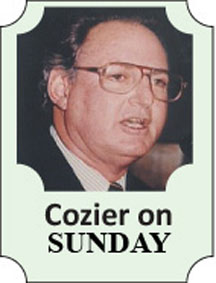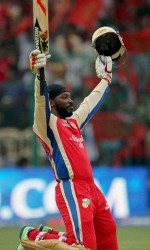The reaction to Chris Gayle’s bombardment in Bangalore last Tuesday was global and suitably awe-struck.
It might have been a Twenty20 match for a franchise team in the Indian Premier League (IPL) and against quite ordinary bowling but the imposing Jamaican left-hander’s unbeaten 175 off 66 balls (passing 100 on the way from 30 deliveries) was extra special, the kind of performance that transcends its particular sport.
Every newspaper I raised on the internet, and not only those within cricket’s limited boundaries, proclaimed his phenomenal hitting that sent 17 sixes into the delirious spectators in the stands, and some onto shattered roofs.
 In person or on their twitter accounts, players, past and present and those present at the Chinnaswammy Stadium, didn’t hold back in their acclaim.
In person or on their twitter accounts, players, past and present and those present at the Chinnaswammy Stadium, didn’t hold back in their acclaim.
Darren Sammy tweeted, or is it twittered?, “he’s not human..he’s a tsunami mixed with a nuclear bomb” (Nice one skipper). Brian Lara who revealed he was at home “chilling watching some awesome hitting”, said he liked the line that when “Gayle bats fielders become spectators and spectators become fielders”.
Indian captain M.S.Dhoni’s comment was: “Life is all about taking the right decision, seeing Gayle bat today I think I took the right decision of being a wicket keeper.” And so on and so forth.
We were lucky in the Caribbean that it was breakfast time and, through Sportsmax, we, too, could marvel at the phenomenon over our favourite morning dish.
Yet, as remarkable as it all was, it was surely not entirely unexpected.
Gayle has long since established himself as one of the most devastating hitters the game has known (although reference to Viv Richards, Clive Lloyd and others of the pre-Twenty20 age raises an understandable argument with Simon Hughes’ assertion in the Daily Telegraph that he “hits the ball harder and further than anyone in the history of cricket”).
In that regard, Indians might well mention the names of their own Master Blaster, Virender Sehwag, and Dhoni himself; Australians could put forward Adam Gilchrist, Sri Lanka Sanath Jayasuriya.
In a bygone era, before the official sanction of limited-overs cricket when sixes were frowned on, the famous master blasters were the Australian Victor Trumper, the Englishman Gilbert Jessop and our own Learie Constantine (who argued that the best place to hit the ball was in the air as there was no one there to catch it).

Whoever else is in the frame and from whatever age, Gayle is surely the all-time king of sixes. He has launched 337 of them in 345 internationals for the West Indies (84 in 121 Tests, 193 in 242 ODIs, 60 in 32 Twenty20s). These don’t count the several in domestic Twenty20s around the world. It is an unofficial title accentuated by last week’s blitz.
Such statistics and Gayle’s unconventional technique cause him to be dismissed by the perfectionists as nothing more than a leaden-footed slogger who relies almost exclusively on brute force and on a tree trunk of a bat. He’s alright for the artificiality of the abbreviated game, goes the reasoning, not for the genuine article of Test cricket that more accurately examines every facet of batting.
Such condescension ignores Gayle’s overall record.
He is one of only four batsmen to twice score over 300 in Tests (Sehwag is another along with Brian Lara and Don Bradman) – 317 against South Africa at the ARG in 2003, 333 against Sri Lanka in Galle in 2010. Each occupied more than ten and a half hours.
Against Australia at Adelaide in 2009, when captain, he carried his bat through the innings for 165 off 285 balls as West Indies pressed for victory they couldn’t quite pull off; in the next Test, a few days later in Perth, he paraded his versatility with 102 off 72 balls, with six sixes.
My favourite – well, one of them – was his 197 when the West Indies threatened to collapse against New Zealand at Napier in 2009. He spent 396 balls repairing the innings, adding 124 with the reliable Brendan Nash (remember him?); yet it didn’t prevent him hoisting huge sixes whenever the relevant ball came along.
The seven maximums was then a West Indies Test record; he surpassed that with nine in his 333 two years later.
Gayle’s ability is not based on his physical strength alone. He clearly possesses the keen eyesight and reflexes that all ball-sport champions require. And, as much as anythin
g, there is the complete self-confidence that permits him, for instance, to pummel the first ball of a Test over the ropes, as he did in Bangladesh last November. No one else has ever done that.
Just as Gayle’s batting is so often misjudged, so the man himself.
It has led to his several fall-outs with the West Indies Cricket Board (WICB) and his suspension for 18 months over one mismanaged issue.
He has said there is no love lost between the two, a lack of trust that influenced him to turn down a retainer contract.
His obvious enjoyment of life (as with his Gangnam-style celebrations following the World Twenty20 triumph and his dressing room skylarking) is typical of young West Indians. It makes him popular with players, fans and, away from the Caribbean, with those teams that vie for his signature.
He also happens to be arguably the best all-round batsman in the modern game that now encompasses three different formats.
++++++++++++++++++++++++++++++++++++++++++++++++++++++++++++++++
IT would have been intriguing to have had the WICB’s directors’ meeting in Port-of-Spain over the past two days bugged and to have listened in.
It was the first since Dave Cameron defeated Julian Hunte in what was a contentious election for president. It has emerged that what tilted the balance, 7-5, in Cameron’s favour were both votes from the Barbados Cricket Association (BCA) delegates and another from the Leeward Islands who went against their mandate and plumped for Cameron and his running mate, Emmanuel Nanthan.
It was significant that the BCA was one WICB affiliate not to congratulate the winners on their election. That, of course, would have been hypocritical. It is not difficult to imagine what their mood would have been in Port-of-Spain over the last two days.




